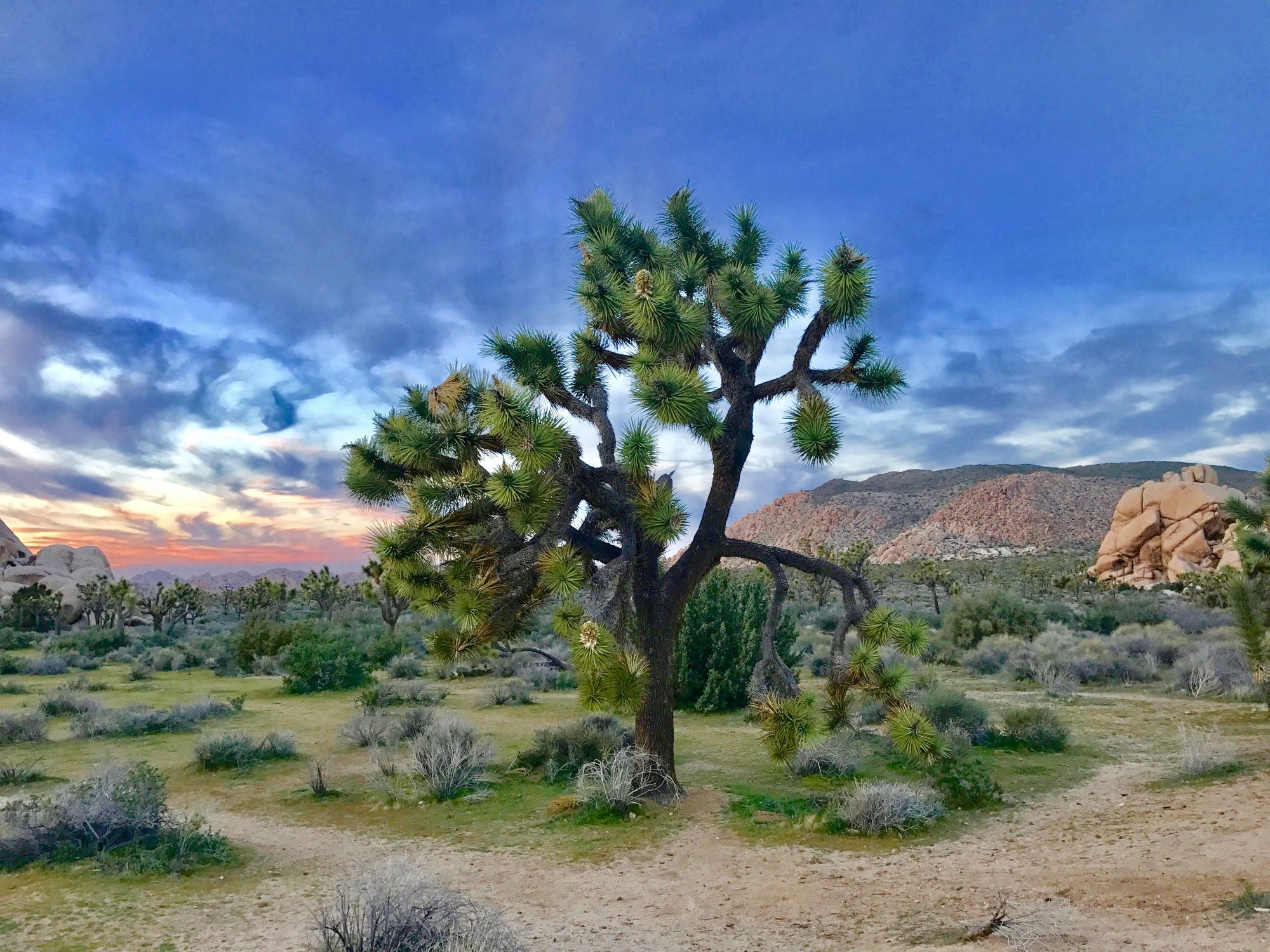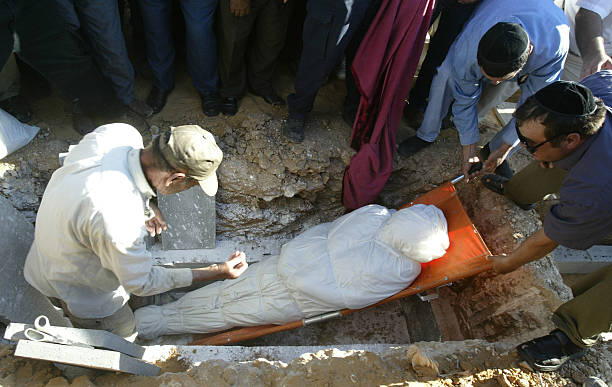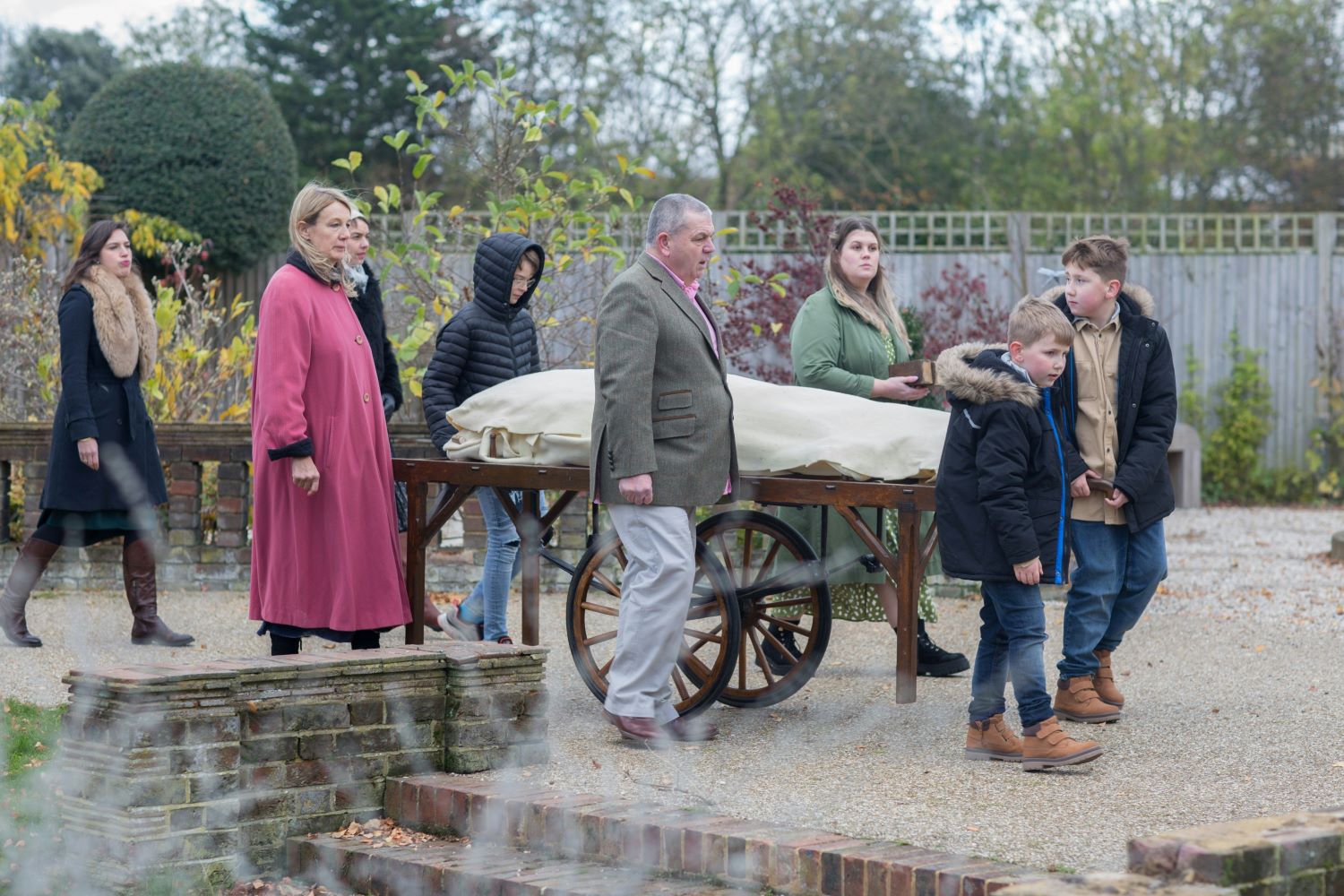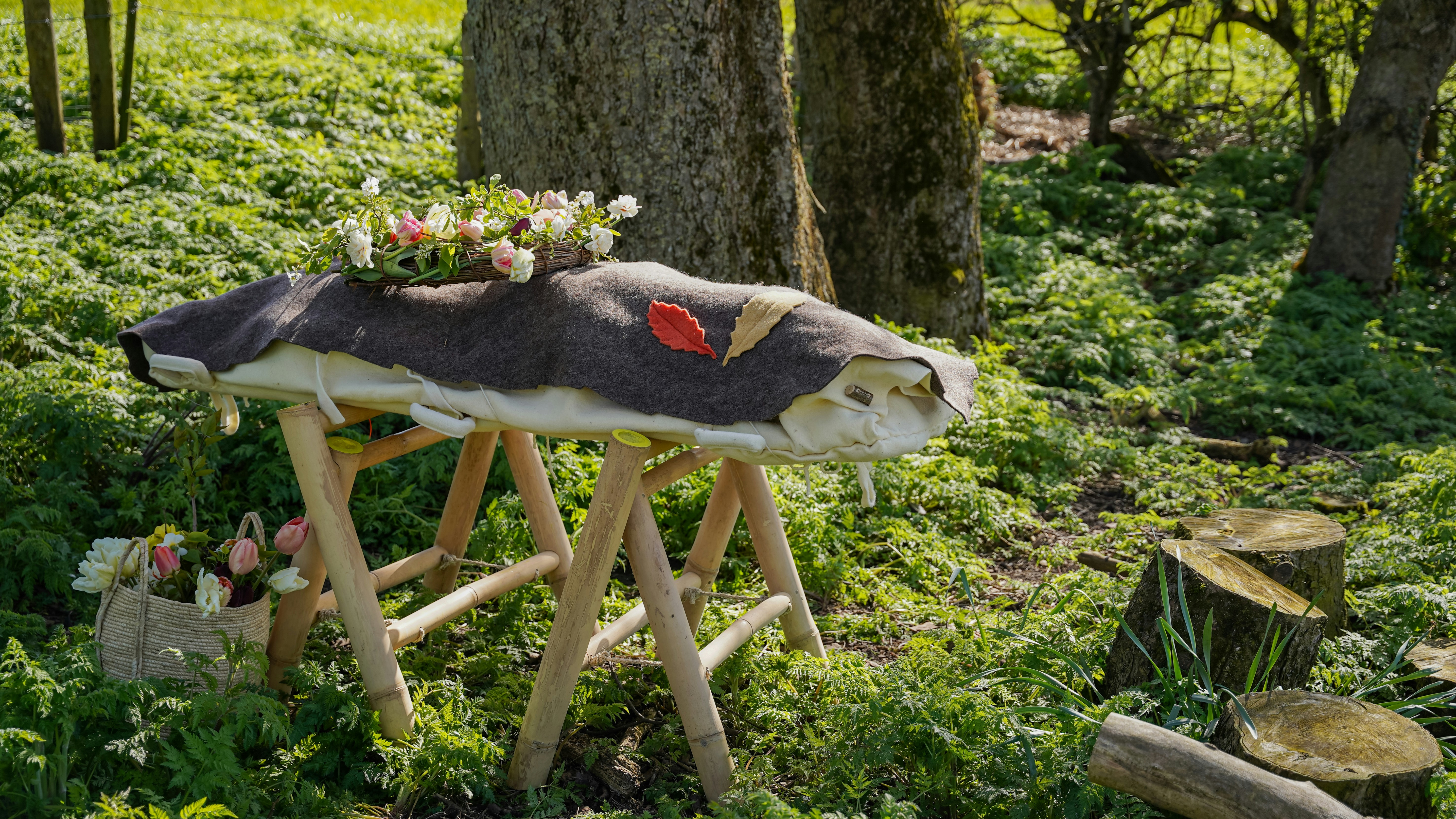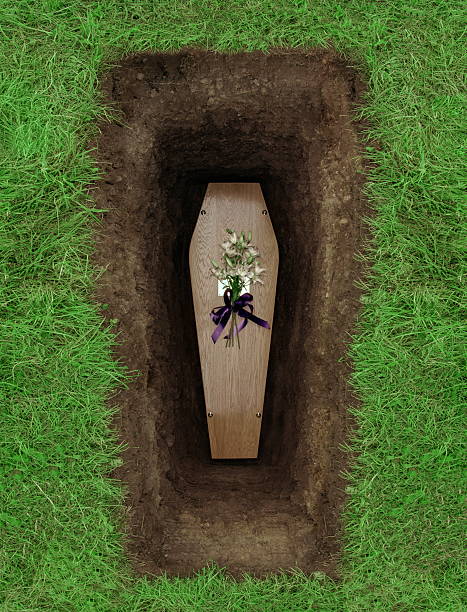Sunset in Joshua Tree National Park: the sky is painted with hues of purple, green, blue, red, and gold. A figure, snugly wrapped in an ivory-colored linen shroud, is slowly being lowered into the warm embrace of the desert. As the plain wooden boards are gradually angled, then finally removed, the small group of people gathered here is silent for a long moment. Only the low whirring of insects, sympathetic coos of evening birds, and the soft music of wind gently buffeting the sand around their feet graces their ears. This is a natural, or green burial, and it proceeds without the halting hand of a myriad of industrial chemicals, vaults of steel and concrete, and a gasket sealed casket. By choosing to decay, the person now resting peacefully in the earth will soon be experiencing a kaleidoscope of colors all their own. A choice that is not only environmentally friendly and financially sensible, but which also provides the same comforts to bereaved families as traditional funerals.
The world’s first “official” natural burial site opened in the United Kingdom at Carlisle Cemetery, in 1993. Dubbed the Woodland Burial, it features graves in a forested setting with native trees planted to replace traditional headstones. Interest in the idea coupled with the intensifying environmentalist movement in the early 1990’s and spurred the development of nearly 300 additional natural burial sites available to citizens of the United Kingdom alone. Burial without all the modern accoutrements is no great revelation however, as humans all over the world have been interring their dead this way for thousands of years. Jewish families have practiced natural burials for generations, their bodies laid into the earth wrapped with a simple white shroud, inside a bare pinewood coffin, unmarred by the harsh chemicals required for staving off decay. Natural burials are nothing new to the indigenous peoples of the Americas either. Though each individual tribe has a death ritual and custom unique to it, an overriding theme according to Native American funeral director Toby Blackstar, is that “the Creator or the one that we call God has given us a body and that body must then be allowed to break down and go back to mother earth just as mother earth formed our bodies.” Even as recently as the Victorian era people were practicing “green” burial in the United Kingdom as well as in the United States, with family members caring for and displaying their dead in the home until final burial in a churchyard, or one of many sprawling rural cemeteries.
How then did we come to what most Americans view as a traditional funeral? The standard two-day affair, which includes embalming and the application of specialized mortuary cosmetics to prepare the body for an obligatory viewing, takes root just after the American Civil War. Brought on by the high-profile case of Army Medical Corps Colonel Elmer Ellsworth, the first union officer to be killed and a close friend of then President Abraham Lincoln. After he was shot removing a giant confederate flag from the roof of a hotel neighboring the White House, Col. Ellsworth’s body was embalmed by Doctor Thomas Holmes, who offered his services to the family of the fallen hero. Once his body was prepared, it was held in state at the White House for several days before moving on to New York City where thousands of people lined up to view the funeral cortege. After seeing the body of his late friend so well preserved, President Lincoln became an early proponent of the technique and requested that his son Willie be embalmed upon the child’s death from typhoid fever the following year.
During the Civil War, and until it ended in May of 1865, the bodies of most soldiers were either left where they fell or transported to mass graves for burial, but many northern families of means were intent on bringing their fallen home. Due to the heat and humidity of the south and the time it took for the return railroad journey, the process was difficult and the bodies unpleasant to handle upon arrival. Fortunately for them Jean-Nicolas Gannal, a French chemist, had published a book merely 25 years earlier detailing the first technique for arterial embalming and its popularity in America began to swell as battlefield surgeons performed “field embalming” on the bodies of soldiers headed for home. Of the 600,000 dead in the aftermath, it is estimated that nearly 40,000 soldiers received this treatment. The exact method and chemicals used varied from embalmer to embalmer however, causing unpredictability in consistency and length of preservation.
A strictly military practice at first, after the use of the technique on young William Lincoln, the same doctor was called in to perform an embalming procedure on the President himself when he was assassinated just three years later. This was in preparation for his historic funeral train parade that would carry him to his final resting place in Springfield, Illinois. This was the first, and only, time a procession like this took place for an American president and people waited in line for many long hours to get a glimpse of Lincoln’s preserved corpse. Seeing the dead President’s body with lifelike color and less rigid features made a strong impression on people and marked the beginning of the end for Victorian mourning traditions in America. The family effort of washing and preparing the body for display in a home wake gave way to commodified death and headed into the realm of professionalized undertakers, taxi drivers turned hearse renters, and traveling embalming chemical salesmen.
Though this service was undoubtedly helpful in obtaining closure and some peace of mind for the families who could afford it, over one hundred and fifty years later the deadly chemicals used to preserve these young men are still seeping into the ground of many Civil War era cemeteries. A study performed in 2002 at Iowa City on one of these cemeteries found nearby water contained arsenic, a toxic mineral which causes various cancers, at three times the federally mandated safety limit. Popular death author Caitlin Doughty remarks in her book, Will My Cat Eat My Eyeballs? — “It’s not the soldiers’ fault. Their decomposing bodies wouldn’t cause cancer if we hadn’t stuffed them full of arsenic. Fortunately, embalmers stopped using arsenic over a hundred years ago—though formaldehyde (arsenic’s replacement) isn’t without its own toxic problems.”
Formaldehyde, with its unmistakable smell, is one of the things most strongly associated with modern funerals. Teenagers get their first whiff of the highly toxic chemical when dissecting worms, frogs, or fetal pigs in biology classes across the country. But they are nowhere near the exposure rate of professional embalmers, who were found to be exposed to an average of 9 parts per million (ppm) while actively embalming, despite the Occupational Health and Safety Administration’s permissible exposure limit being 0.75 ppm. These high exposure levels make embalmers more susceptible to chronic bronchitis as well as eye and skin irritation. Many studies have shown an increased risk for cancers of the skin, brain, colon, sinuses, nose, throat, and blood, as well as kidney failure, arteriosclerotic heart disease, chromosomal damage, and cirrhosis of the liver.
The dangers of formaldehyde go well beyond the embalming prep room however, as it can enter water tables similarly to its Civil War era predecessor. It has been found to last up to 250 hours in the air after an embalmed body is cremated, its highly soluble nature helping it to cling to atmospheric moisture before washing out as precipitation. Even before it enters a human corpse, wastewater discharge from embalming fluid manufacturers has been found by the World Health Organization to injure or kill developing marine plant life. This environmental damage of traditional cemeteries can be mitigated and in some cases reversed, as many studies have shown that burial sites devoid of animal life improve after the transition to natural burial, with deer, hares, hedgehogs, voles, owls, and other wildlife returning. Additionally, according to bereavement services specialist Ken West, in a natural burial:
“The carbon in the body and coffin is locked up and will be absorbed by the tree or vegetation on the grave. The carbon advantage is not restricted to one year because natural growth goes on sequestering carbon year on year for at least 75 years. Undisturbed wildflower turf is now understood to lock up carbon, and natural burials beneath a tree will do this for long periods. In my experience, many of the relatives of the deceased do not regularly return to a natural burial grave because they understand the need to reduce vehicle use.”
The use of formaldehyde to preserve the bodies of our loved ones is so pervasive and widely accepted that despite all the risks involved most people balk at the thought of going without the harsh chemical process. While one of the main arguments for preserving corpses in this way is the psychological benefit to family members from holding a public viewing and funeral, it is not necessary in the age of refrigeration. Unrefrigerated, bodies will keep under normal conditions for a full twenty-four hours in most cases, and beyond that they can be refrigerated or frozen, and then kept on display with either dry ice, or a water-proof clear plastic pouch containing lime, allowing the bereaved ample time to arrange and hold services. In the modern world of fast transportation and widely available cold storage, viewings can proceed without the use of such toxic chemical preservatives.
Common sense would suggest that rotting human corpses could be dangerous, and a probable risk to public health is often the most popular argument for embalming. Many funeral laws are based on this misguided fear which overstates the role of embalming, because though it does kill many infectious organisms, many more may remain. The only real health risk corpses pose comes from communicable diseases such as typhoid or cholera, but in many ways the infected dead are safer than the living. In her exposé of abuses in the funeral home industry, The American Way of Death Revisited, Jessica Mitford put it succinctly saying dead bodies “don’t excrete, inhale, exhale, or perspire.” Additionally, during the embalming process infected blood is washed into the sewer system, instead of being properly disposed of as medical waste.
The American funeral industrial complex is pumping corpses full of this highly toxic chemical cocktail at the rate of 4 million gallons a year, then encasing them in 64,000 tons of steel and 1.6 million tons of concrete, thus elongating the inevitable decomposition progress. This is enough steel each year to build the Golden Gate Bridge, and enough concrete to pave a two-lane highway from New York City to Detroit. All this effort to stave off decay and the natural process of decomposition which, no matter the time scale, almost all bodies will experience. There is a much simpler, faster, cheaper, and safer alternative to the modern burial standard.
In a relatively warm spot with plenty of insects and scavengers around, a human body can be turned to bones in a scant few weeks and disappear completely in a matter of months. Green burial provides this simple solution, while protecting the environment and honoring a variety of cultural burial traditions. As Doughty puts it in her ruminations on embracing decay, “It is how humans have been buried for thousands of years. The simple equation of body, dirt, bugs, bacteria, and decomposition. A few short weeks and you are nothing but skeleton, all other parts of you having gone their separate ways.” As previously discussed, many predominate religions such as Islam and Judaism already practice natural burials and others have been quick to adapt, with the Lutheran Church adopting it as a common practice in recent years.
Green burials have also been entering into the realm of Catholicism, with many communities of nuns embracing the practice as a compliment to their lifelong dedication towards environmental stewardship. This is important because what is acceptable to the Catholic Church often sets the standards for mainstream Christianity worldwide, regardless of denomination. Author Kristel Clayville spent time with a group of these Sisters who are utilizing green burial practices to protect the land around them from being developed thus preventing further endangerment to the flight paths of migratory birds. After living side by side with the Sisters of Loretto, she writes:
“The Sisters and their community have an integrated philosophy of how they fit into the natural world. They are part of it, yet also responsible for it. They live out this philosophy practically in all of their decisions, from how to use their farmland, to energy conservation, to their eternal interment. While I had read environmental philosophy and ethics for years, I had not seen it lived out for more than a brief instant, and here I was seeing it put into practice over the span of lives.”
The movement has become so popular that the American Association of Retired Persons (AARP) added green burial to their Funeral and Burial Planners document in 2007, recommending it as not only environmentally friendly, but financially savvy. The cost difference is glaringly obvious, as the typical American funeral costs more than $8,000, which the price before adding the cost of the cemetery plot that stacks on another $1,000 to $4,000. Green cemetery space does run a little higher with costs ranging from $2,000 to $4,500, but without the addition of costly caskets and vaults, the cost of the plot and the cost for a funeral home’s services (a topic for another time) are the only major expenses grieving families will incur.
Though there will always be cases where embalming is useful, such as preserving medical school cadavers for extended viewing or safeguarding the bodies of soldiers being shipped home from foreign wars, it is time for its use in typical American funerals to fade away. Choosing a green burial can bring the same comforts as a traditional funeral to grieving families, while saving them money and empowering them to make a positive impact on the environment. If we move towards accepting our inevitable decay, like Buddhists meditating on the ten stages of human decomposition, or Medieval Christians displaying Memento Mori, artistic reminders that their time would come, we can make better informed choices on what happens to our bodies after death. By deciding to end our life’s journey in the wild technicolor show that is decomposition, we can return to nature the matter which it has loaned us, and let the universe reuse us as it sees fit.

